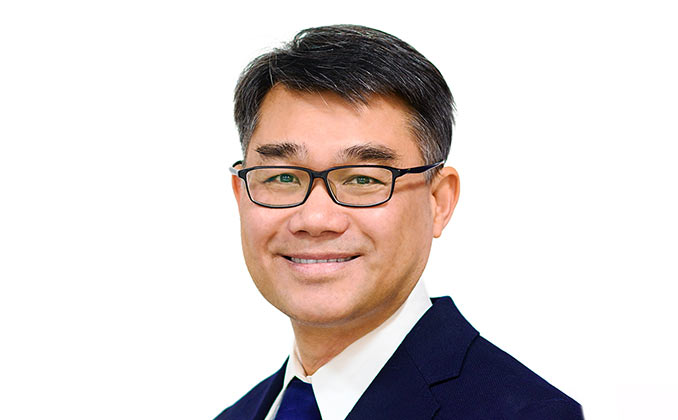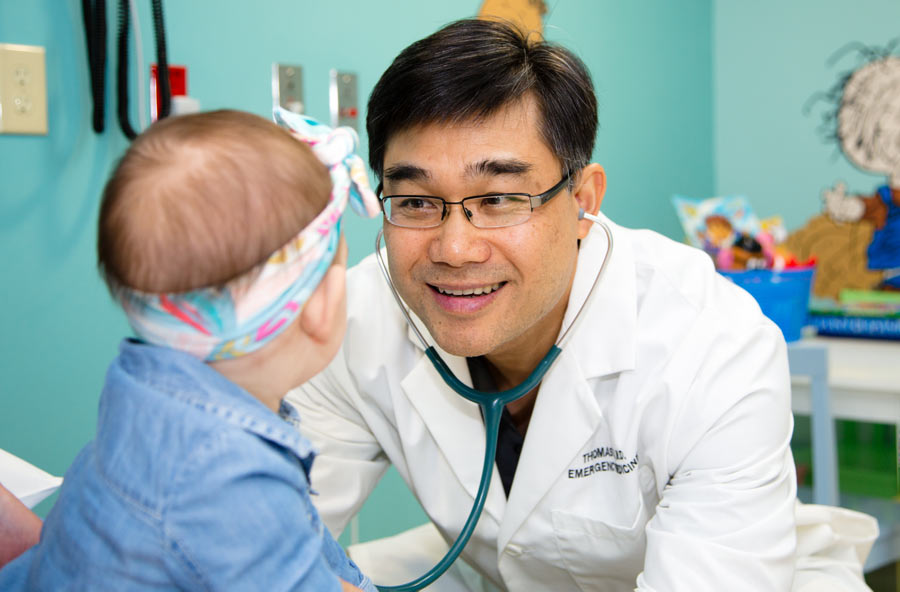Ignite | Fall 2022
Scaling Innovation and Manifesting Happiness: Tom Vo
BY RODERICK L. INGRAM SR.

Tom Vo, M.D.
In a McKinsey and Company article titled, “The Future of US Healthcare: What’s Next for the Industry Post-COVID-19,” the authors discuss shifts to the non-acute care setting, noting that care-delivery services outside the hospital are the fastest growing businesses for providers.
Nutex Health’s brand promise of being an “innovative service provider in the emergency care industry,” reads like it might be among those newly accelerated care-delivery services that emerged over the last few years.
But disruptive innovation is different. It often happens years ahead of trending, responsive, in-demand approaches. In fact, resulting products and services are usually introduced years before customers even realize they need them.
Such is the case with the micro-hospital facilities and turnkey solutions offered by Nutex Health, a company created by Tom Vo, M.D., a 1996 graduate of NEOMED’s College of Medicine. Dr. Vo launched his micro-hospital concept nearly 15 years ago. While there was no pandemic at that time, there was a dire need to address critical issues endemic to health care — patient dissatisfaction, poor health outcomes and high costs.
But in 2009, when Dr. Vo opened his first facility in Houston, Texas, many weren’t quite sure what it was — after all, his idea wasn’t necessarily created in pursuit of the Triple Aim to improve the experience of care, population health and per capita cost.
He really just wanted patients — and providers — to be happy.
NOT VERY GOOD, BUT VERY HAPPY
In 1992, at just 20 years old, upon accelerating through his bachelor’s degree at Kent State University — through NEOMED’s former six-year program — Dr. Vo admits that his time at NEOMED wasn’t easy. “Honestly, medical school was pretty tough,” Dr. Vo said, as if he was in some sort of confessional.

As Tom Vo, M.D., witnessed the negative experiences encountered by patients in emergency rooms, he was inspired to create something different.
“Having said that, I think the adversity created the person who I am and the business success that we have (at his company),” he added.
He also started his company long before he took a single business course.
“My affinity for helping others inspired me to study medicine. But I think NEOMED was a very good education, not just from a medical standpoint but also from an everyday, social, people standpoint,” Dr. Vo said. “I learned to interact with other people, see how doctors and future doctors think … know what presses their buttons.”
Dr. Vo was always observing others, developing his emotional intelligence. As a doctor-in-training, he knew exactly where he wanted to be: in a place where people were happy.
After receiving his Doctor of Medicine degree in 1996, the Stow, Ohio, native matched at the William Beaumont Hospital in Royal Oaks, Michigan, for his Emergency Medicine Residency.
In 2000, Dr. Vo and his wife, Kim, also a NEOMED graduate (’97), moved to Kim’s hometown of Houston.
WHERE CREDIT IS DUE
For the next 10 years, Dr. Tom Vo worked in busy hospitals and emergency rooms throughout Texas. He also got his M.B.A. in 2004 from Rice University to learn more about the business side of medicine. As he witnessed the negative experiences encountered by patients in emergency rooms, he was inspired to create something different. Dr. Vo’s desire to see smiling customers and co-workers and a culture where people were truly happy propelled him into a novel business idea of how to provide emergency care. And so, in 2009, he opened his first freestanding emergency center.
Dr. Vo named his business Nutex (short for New Texas) Health. He said he could not have done it without the support of his wife, Dr. Kim Vo.
Upon expanding his facilities rapidly throughout Houston, then other parts of Texas, including Austin and Dallas, Dr. Vo started noticing all of the happy faces — staff and patients. Emphasizing such success is a team effort, Dr. Vo said, “When we started seeing high Google reviews and comments from patients such as, ‘I was treated at x hospital, and you guys saved my life,’ that meant everything to me.
“You have to have happy clinicians and staff if you want happy patients,” he added.
During this same time, as the health care industry was already struggling in pursuit of the Triple Aim, survey upon survey revealed yet another issue that was critical to health outcomes: provider burnout.
In 2014, a study titled “From Triple to Quadruple Aim: Care of the Patient Requires Care of the Provider,” was published in the Annals of Family Medicine. The article referenced various surveys and studies regarding physician burnout, one of which indicated: The wide gap between societal expectations and professional reality has set the stage for 46% of US physicians to experience symptoms of burnout. Widespread across specialties, burnout is especially prevalent among emergency department physicians, general internists, neurologists and family physicians.
Especially emergency department physicians.
At Nutex Health’s micro-hospitals, this was not the case. “No one’s stressed out; no burn out,” said Dr. Vo. “and in fact, our model extends the physician’s careers by 10-15 years.”
In 2018, Nutex Health began its nationwide expansion.
WHEN THEY GO BIG, WE GO SMALL
A 2017 research report from the Deloitte Center for Health Solutions and the Healthcare Financial Management Association shows that there were more than 750 hospital acquisitions or mergers between 2008 and 2014. And of the nearly 5,000 hospitals in the United States, nearly 60 percent are part of a health system.
Dr. Vo took an alternate route — micro-hospitals. He would expand Nutex Health and build its brand as the premier innovative service provider in the emergency care industry. As a value proposition to physician-owners, Nutex Health would deliver a turnkey process from real estate acquisition, design and development of the ER facility to staffing, training and operations.
“They [physicians] have equity in the hospital. It changes the way they practice medicine, and it changes the financial perspective for families,” said Dr. Vo. “Clinicians get to spend more time with the patient. The pace is much better for our physicians, nurses and technicians too. Our entire staff have a better work/life balance.”
The micro-hospitals offer up to 10 in-patient beds with the idea that they could be put anywhere in the country and be much more economical than the traditional hospital. Providers treat ER patients, and whoever they can’t accommodate they transfer out.
They don’t compromise service or personal well-being.
The possibility of concierge-level service is the ultimate payoff for Nutex Health’s disruptive model.
The model includes partnerships with Independent Physicians Associations (IPAs). An IPA is a business entity organized and owned by a network of independent physician practices for the purpose of reducing overhead or pursuing business ventures.
“No one has ever combined micro-hospitals with IPAs,” Dr. Vo said. “Our primary care doctors receive a set amount of insurance payments, and we take out the risk of treating patients. If they save money by improving the health and experiences of our patients, they can keep profits.”
It is all value-based.
“We changed a lot of people’s lives. Not just within the community but we worked with over 250 doctors – and extended referral sources make it around 1,000 doctors,” Dr. Vo.noted
Recognized by his contemporaries as one of the pioneers and leaders in the field, Dr. Vo received the prestigious EY Entrepreneur of The Year® award in 2020.
Nutex Health Inc. went public in 2022. “N-U-T-X on NASDAQ,” Dr. Vo said proudly. “We’re doing pretty well and the public is really embracing the micro-hospital concept.”
The company currently has 1,500 employees, 250 doctors, 600 doctor referrals and 22 hospitals across eight states, with another 20 anticipated opening in a total of 13 states.
STAYING AGILE
“We hope to have 100 locations in the next 10 years,” Dr. Vo proclaimed.
But wouldn’t that eventually make this small company big like the others?
If the micro-hospitals maintained their current average of six beds each — a total of fewer than 700 beds across 110 micro-hospitals — Nutex Health would still have less beds than the country’s largest hospitals.
With five-fold growth, what will happen to the company’s culture and customer satisfaction?
Dr. Vo is aware of the challenges of growth. And when asked, he reels them off quickly:
Getting buy-in: Explaining the vision of something that didn’t exist before can be difficult. However, it’s not hard to convince physicians to invest in their future through our hospital platforms.
Maintaining culture: Getting the right physician partners, individual personalities and aligning incentives with everyone in the organization, from the physician down.
Building leadership: You can’t be everywhere — our culture fosters leadership so that we have multiple capable leaders that lead each of the individual hospitals. My job is to create and foster those leaders.
Billing and collections: Getting paid from insurance companies is no small task. We take revenue collection extremely seriously. If we can’t collect revenue, we can’t grow.
“And that’s all compounded by going public, which makes you a lot more visible,” Dr. Vo said. “It’s not just doctor-investors. Public investors could be teacher pensions funds, national police organizations, friends, neighbors and so on.
“People enter medicine for a reason – to help people. Ninety-nine percent of doctors want to provide patient care, not own businesses,” he said. “But, for those who want to improve health through other means, including administration and leadership, we help with the business of medicine by providing solutions for overcrowded ERs and the high cost of medicine.”
Next year, Nutex Health will finally open a micro-hospital in Dr. Vo’s home state of Ohio — in Columbus, to be exact.
He is looking at 21 more sites across the country — mostly in communities with the biggest need, where patients are sometimes waiting in the ER for eight to nine hours.
Meanwhile, he makes sure he maintains balance, enjoying life with his wife, Kim, and their four kids.
“My family makes me happy. Time with them is fun. I also exercise and do martial arts for fun,” he said.
With work, he says he’s not trying to reinvent the wheel with each new site. It’s just: Stamp. Build a hospital. Repeat.
“But work is also fun,” Dr. Vo said. “Our team sees a problem. We find solutions. We make a difference. That makes them happy. Our patients are happy. I am happy.”
